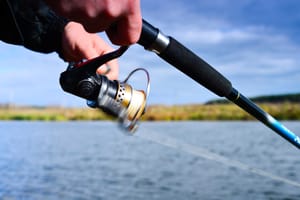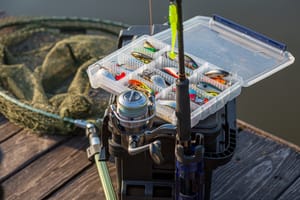Walleye fishing is both a science and an art, and one of the most critical components of your tackle when targeting this popular game fish is the jig head. Knowing what size jig head for walleye to use can be the difference between a successful outing and coming home empty-handed. This article will delve into the nuances of selecting the perfect jig head size for walleye fishing, ensuring you're well-equipped for your next trip.
Key Takeaways:
- Understanding the importance of selecting the appropriate jig head size for walleye can significantly improve your fishing success.
- Factors such as water depth, clarity, and walleye feeding habits influence the choice of jig head size.
- A range of jig head sizes from 1/8 oz. to 3/8 oz. is typically effective for walleye, depending on the conditions.
Understanding Walleye and Their Habitat
Walleye are known for their keen eyesight, which they use to their advantage in low-light conditions. This means that the size of your jig head can play a significant role in how visible or attractive your lure is to these discerning fish. Walleye typically inhabit waters with varying levels of clarity and depth, which necessitates a versatile approach to jig head selection.
When fishing in clearer waters, walleye can be more selective, often requiring smaller, more natural-looking presentations. Conversely, in murkier waters, a larger jig head can provide the added weight and profile needed to get their attention. Additionally, the depth at which you're fishing will influence your choice, as deeper waters often require heavier jig heads to maintain contact with the bottom.
The Role of Jig Head Size in Walleye Fishing
The size of the jig head you choose for walleye fishing is crucial because it affects both the action of the jig and its sink rate. A heavier jig head will sink faster and can be beneficial in deep water or strong currents, allowing you to maintain better control of your lure. On the other hand, a lighter jig head will fall more slowly, which can be advantageous when fishing shallow waters or when walleye are feeding on smaller prey.
The most common sizes for walleye range from 1/8 oz. to 3/8 oz. A 1/8 oz. jig head is excellent for shallow water or when you want a slower presentation. A 1/4 oz. jig head is a versatile middle-ground option that works well in a variety of conditions. For deeper water or when dealing with heavy current, a 3/8 oz. jig head may be the best choice to keep your bait in the strike zone.
Seasonal Considerations for Jig Head Selection
Seasonal changes can also dictate what size jig head for walleye is most effective. During the spring spawn, walleye are often found in shallower waters, making lighter jig heads more appropriate. As the water warms up in summer and walleye move to deeper, cooler areas, a heavier jig head may be necessary to reach them.
In the fall, as walleye begin to feed more aggressively in preparation for winter, they can be found at varying depths throughout the day. This means you may need to adjust your jig head size accordingly, switching between lighter and heavier options as you track the fish's movements. During the winter, ice fishing for walleye often requires a different approach, with smaller jig heads often being the go-to choice.
Matching Jig Head Size with Bait and Technique
The type of bait you're using can also influence the size of the jig head you should select. When using live bait such as minnows or nightcrawlers, a lighter jig head can allow for a more natural presentation. For soft plastics or artificial lures, you may need a slightly heavier jig head to achieve the desired action.
Your fishing technique is another factor to consider. If you're casting and retrieving, a medium-weight jig head can provide the right balance of casting distance and control. For vertical jigging, a heavier jig head can help you stay in contact with the bottom and feel subtle bites more effectively.
Jig Head Features and Walleye Attraction
Beyond size, the features of the jig head can also impact its attractiveness to walleye. Jig heads with bright colors or reflective finishes can be more visible in murky water, while those with a more subdued, natural appearance may be better in clear conditions. Some jig heads also come equipped with rattles or other sound-producing elements that can entice walleye to strike.
It's also worth considering the shape of the jig head. Round jig heads are a standard choice that works well in most situations, but other shapes like football or bullet can offer different actions that may be more appealing to walleye under certain conditions.
Summary
Selecting the right size jig head for walleye is a critical aspect of successful walleye fishing. Factors such as water clarity, depth, season, bait type, and fishing technique all play a role in determining the best jig head size to use. Generally, sizes ranging from 1/8 oz. to 3/8 oz. will cover most situations, with adjustments made based on specific conditions. By understanding these nuances and experimenting with different sizes and features, anglers can significantly increase their chances of catching walleye. Don't miss our expert roundup of the 7 BEST Walleye Jig Heads for 2024, the essential additions to your tacklebox for a successful fishing season!
FAQ Section
Can I use the same jig head size for walleye in all water conditions?
No, water conditions such as depth and clarity can greatly affect which jig head size is most effective. It's best to have a range of sizes available to adapt to different conditions.
How do I know when to switch to a heavier or lighter jig head?
If you're not maintaining contact with the bottom or your jig isn't reaching the desired depth, you may need a heavier jig head. Conversely, if your jig is sinking too quickly or getting snagged, a lighter jig head might be necessary.
Are there specific colors of jig heads that work best for walleye?
While color can be important, it's often secondary to size and action. However, in general, bright colors or those that mimic natural prey can be effective in murky water, while more natural tones are better in clear water.



